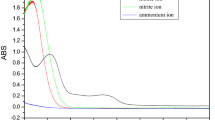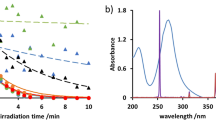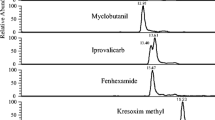Abstract
Quinoxyfen has been recently identified as a priority hazardous substance in the field of the European water policy. In this work, its fate in aqueous samples and solid supports under UV and solar radiation is investigated. Diverse degradation experiments were carried out, at lab scale, using spiked aliquots of different aqueous matrices (ultrapure, treated wastewater and river water) irradiated at different wavelengths (λ = 254 nm, λ = 365 nm and solar light). Half-lives of quinoxyfen (2–26 min) depended on the wavelength and the intensity of radiation whilst the nature of the aqueous matrix did not play an important role in degradation kinetics. Moreover, experiments under solar radiation of doped silicone tubes were performed to simulate degradation when quinoxyfen is adsorbed on plant leaves or soil. As the compound is not completely mineralized, the identification of quinoxyfen transformation products (TPs) was performed by liquid chromatography quadrupole time-of-flight mass spectrometry (LC-QTOF-MS) injection of different irradiated time aliquots. The full-fragment ion spectra, at different collision energies, allowed the elucidation of the chemical structure of TPs formed by hydroxylation, cyclization or cleavage reactions. Five out of seven identified TPs have not been reported previously. The ecotoxicity simulation by software (TEST and ECOSAR) for TPs revealed that some of them could cause harmful effects to organisms such as Daphnia magna or Fathead minnow in a similar extent to the precursor; moreover, the time course profiles of major TPs (TP1 and TP2) revealed a much higher resistance to further photodegradation than quinoxyfen.

Quinoxyfen phototransformation pathways







Similar content being viewed by others
References
PPDB, Pesticide Properties DataBase: quinoxyfen. Ref: DE 795. University of Hestfordshire. http://sitem.herts.ac.uk/aeru/ppdb/en/Reports/580.htm. Accessed Sept 2015.
Kramer W, Schirmer U, Jeschke P, Witschel M. Modern crop protection compounds, 2nd revised and enlarged edition, 3 volume set. Wiley, Weinheim (Germany); 2001.
JMPR no.222. Pesticides residues in food 2006. Joint FAO/WHO meeting on pesticide residues. Report of the Joint Meeting of the FAO Panel of Experts on Pesticide Residues in Food and the Environment and the WHO Core Assessment Group on Pesticide Residues. Rome; 2006. http://www.fao.org/agriculture/crops/thematic-sitemap/theme/pests/lpe/lpe-q/en Accessed July 2015.
European Directive 2013/39/EU. Directive 2013/39/EU of the European Parliament and of the Council of 12 August 2013 amending Directives 2000/60/EC and 2008/105/EC as regards priority substances in the field of water policy. Off J Eur Union. 2013;L226:1–17.
Ribeiro AR, Nunes OC, Pereira MFR, Silva AMT. Review: an overview on the advanced oxidation processes applied for the treatment of water pollutants defined in the recently launched Directive 2013/39/EU. Environ Int. 2015;75:33–51.
Robles-Molina J, Lara-Ortega FJ, Gilbert-López B, García-Reyes JF. Multi-residue method for the determination of over 400 priority and emerging pollutants in water and wastewater by solid-phase extraction and liquid chromatography-time-of-flight mass spectrometry. J Chromatogr A. 2014;1350:30–43.
Müller A, Flottmann D, Schulz W, Seitz W, Weber WH. Assessment of robustness for an LC-MSMS multi-method by response-surface methodology, and its sensitivity. Anal Bioanal Chem. 2008;390:1317–26.
Greulich K, Alder L. Fast multiresidue screening of 300 pesticides in water for human consumption by LC-MS/MS. Anal Bioanal Chem. 2008;391:183–97.
Pareja L, Martínez-Bueno MJ, Cesio V, Heinzen H, Fernández-Alba AR. Trace analysis of pesticides in paddy field water by direct injection using liquid chromatography-quadrupole-liner ion trap-mass spectrometry. J Chromatogr A. 2011;1218:4790–8.
Wode F, Reilich C, van Baar P, Dünnbier U, Jekel M, Reemtsma T. Multiresidue analytical method for the simultaneous determination of 72 micropollutants in aqueous samples with ultra high performance liquid chromatography-high resolution mass spectrometry. J Chromatogr A. 2012;1270:118–26.
Coscollà C, Castillo M, Pastor A, Yusà V. Determination of 40 currently used pesticides in airborne particulate matter (PM 10) by microwave-assisted extraction and gas chromatography coupled to triple quadrupole mass spectrometry. Anal Chim Acta. 2011;693:72–81.
Barco-Bonilla N, Romero-González R, Plaza-Bolaños P, Garrido Frenich A, Martínez Vidal JL, Salas JJ, et al. Study of the distribution of 204 organic contaminants between the aqueous phase and the suspended particulate matter in treated wastewater for proper environmental control. Desalin Water Treat. 2013;51:2497–515.
Bereswill R, Golla B, Streloke M, Schulz R. Entry and toxicity of organic pesticides and copper in vineyards streams: erosion rills jeopardise the efficiency of riparian buffer strips. Agric Ecosyst Environ. 2012;146:81–92.
Chiaia-Hernández AC, Schymanski EL, Kumar P, Singer HP, Hollender J. Suspect and nontarget screening approaches to identify organic contaminant records in lake sediments. Anal Bioanal Chem. 2014;406:7323–35.
Merli A, Reeves G, Meregalli G, Piccinini A, Negri I, Carmignano P, et al. Surface-water exposure to quinoxyfen: assessment in landscape vineyards. J Hydrol. 2010;383:62–72.
Product safety assessment: quinoxyfen. Form No. 233-01132-0714X. The Dow Chemical Company. http://www.dow.com/productsafety/finder/. Accessed July 2015.
Wolters A, Leistra M, Linnemann V, Klein M, Schäffer A, Vereecken H. Pesticide volatilization from plants: improvement of the PEC model PELMO based on a boundary-layer concept. Environ Sci Technol. 2004;38:2885–93.
Castro G, Casado J, Rodríguez I, Ramil M, Ferradás A, Cela R. Time-of-flight mass spectrometry assessment of fluconazole and climbazole UV and UV/H2O2 degradability: kinetics study and transformation products elucidation. Water Res. 2016;88:681–90.
Rodríguez-Cabo T, Rodríguez I, Ramil M, Cela R. Assessment of silicone as support to investigate the transformation routes of organic chemicals under environmental conditions and UV exposure. Application to selected fungicides. Anal Bioanal Chem. 2013;405(2):4187–98.
Casado J, Rodríguez I, Ramil M, Cela R. Identification of antimycotic drugs transformation products upon UV exposure. J Hazard Mater. 2015;289:72–82.
US-EPA Toxicity Estimation Software Tool (TEST). http://www.epa.gov/nrmrl/std/qsar.html. Accessed April 2016.
Kurwadkar S, Evans A, DeWinne D, White P, Mitchell F. Modeling photodegradation kinetics of three systemic neonicotinoids-dinotefuran, imidacloprid, and thiamethoxam in aqueous and soil environment. Environ Toxicol Chem. 2016;35:1718–26.
Acknowledgements
This study has been supported by the Spanish Government, Xunta de Galicia and E. U. FEDER funds (projects CTQ2015-68660-P, GRC 2013-020, EM2014-004) and collaboration of CAPES (Coordination of the Improvement of Higher Education Personnel) of Brazil.
Author information
Authors and Affiliations
Corresponding author
Ethics declarations
In this article, no research with human participants and/or animals was performed.
Conflict of interest
The authors declare that they have no conflict of interest.
Electronic supplementary material
Below is the link to the electronic supplementary material.
ESM 1
(PDF 192 kb)
Rights and permissions
About this article
Cite this article
Ferri, P., Ramil, M., Rodríguez, I. et al. Assessment of quinoxyfen phototransformation pathways by liquid chromatography coupled to accurate mass spectrometry. Anal Bioanal Chem 409, 2981–2991 (2017). https://doi.org/10.1007/s00216-017-0241-x
Received:
Accepted:
Published:
Issue Date:
DOI: https://doi.org/10.1007/s00216-017-0241-x




